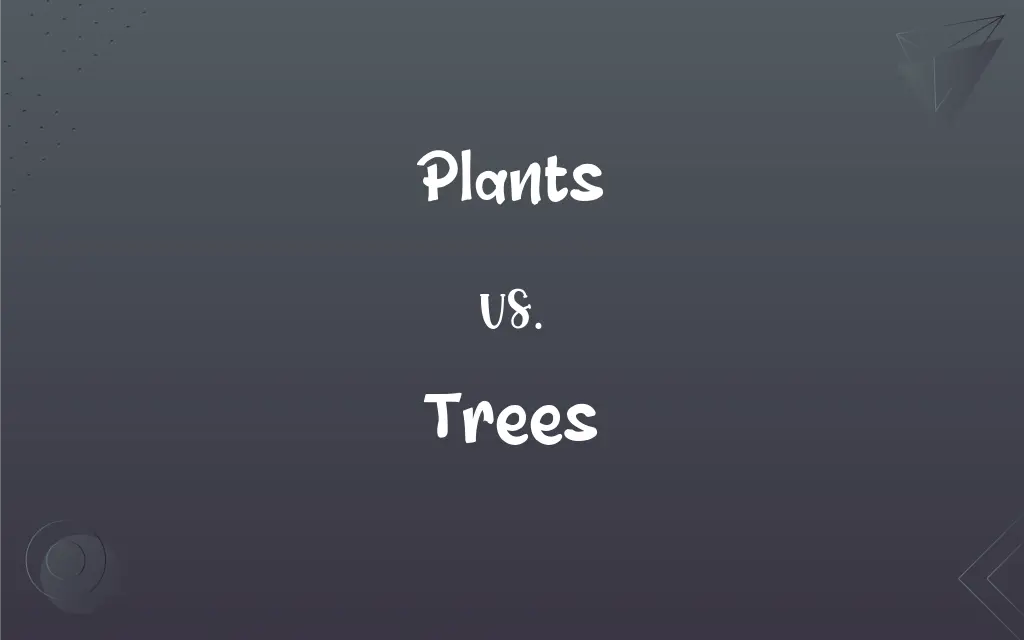Plants vs. Trees: What's the Difference?
Edited by Janet White || By Harlon Moss || Published on February 1, 2024
Plants are a broad category of living organisms including trees, which are tall, woody plants typically with a single trunk and a crown of branches.

Key Differences
Plants encompass a wide variety of living organisms, from small herbs to large trees, which are a specific type of plant characterized by a woody structure and considerable height.
All trees are plants, but not all plants are trees; trees are distinguished by features like a single main stem, whereas plants can be non-woody, like grasses or flowers.
Trees are generally perennial, living many years, and are a subset of plants, which include both perennial and annual species, with diverse life spans.
The size of trees typically overshadows that of most other plants, with some trees reaching tremendous heights, whereas plants can range from tiny ground covers to sizable bushes.
In terms of ecological roles, trees often form forests and provide habitats, while plants, being a broader group, occupy diverse ecological niches from aquatic environments to deserts.
ADVERTISEMENT
Comparison Chart
Definition
Broad group of living organisms
Tall, woody plants with a single trunk
Variety
Includes herbs, shrubs, grasses, etc.
A specific subtype within plants
Structure
Can be non-woody or woody
Characteristically woody
Size
Range from tiny to large
Generally large and tall
Lifespan
Includes both annuals and perennials
Mostly perennials, living many years
ADVERTISEMENT
Plants and Trees Definitions
Plants
Plants include both non-woody and woody species.
Grasses are non-woody plants that cover vast areas.
Trees
Trees can live for many years, often outliving other plants.
Sequoias are among the oldest living trees on Earth.
Plants
Plants can range from tiny mosses to large flowering species.
Orchids are diverse flowering plants with complex blooms.
Trees
Trees typically have a crown of branches and leaves.
Pine trees have needle-like leaves and produce cones.
Plants
Plants are characterized by their ability to grow in various environments.
Cacti are plants adapted to desert conditions.
Trees
Trees are perennial plants with a distinct woody trunk.
Oak trees are known for their strength and longevity.
Plants
Plants are living organisms that typically produce their own food through photosynthesis.
Algae are simple plants found in water.
Trees
Trees are important for providing shade, habitat, and timber.
The baobab tree provides shelter and is a key part of its ecosystem.
Plants
Plants play crucial roles in ecosystems, providing oxygen and food.
The Amazon rainforest is home to a vast array of plant species.
Trees
Trees play a significant role in carbon sequestration and oxygen production.
The Amazon rainforest trees are vital for global oxygen production.
Plants
Any of various photosynthetic, eukaryotic, multicellular organisms of the kingdom Plantae characteristically containing chloroplasts, having cell walls made of cellulose, producing embryos, and lacking the power of locomotion. Plants include trees, bushes, herbs, ferns, mosses, and certain green algae.
Trees
A perennial woody plant having a main trunk and usually a distinct crown.
FAQs
What is a tree?
A tree is a perennial plant with a woody trunk and a crown of branches.
Can plants be non-woody?
Yes, many plants like flowers and grasses are non-woody.
What defines a plant?
Plants are living organisms that typically conduct photosynthesis.
Do trees have a significant lifespan?
Yes, many trees have long lifespans, often outliving other plants.
Are all trees considered plants?
Yes, all trees are a specific category of plants.
Are plants important for the environment?
Yes, plants are crucial for ecosystems, providing oxygen and habitats.
Do trees always have a single trunk?
Most trees have a single trunk, but some species can have multiple.
Do all plants produce flowers?
Not all plants produce flowers; some reproduce through other means.
Can plants be found in all environments?
Yes, plants adapt to a wide range of environments from deserts to aquatic areas.
Can plants survive in water?
Yes, there are many aquatic plant species adapted to living in water.
Are trees a renewable resource?
Yes, trees can be a renewable resource when managed sustainably.
Can trees help combat climate change?
Yes, trees absorb carbon dioxide, helping to mitigate climate change.
Are all trees tall?
While many trees are tall, there are also smaller tree species.
Can plants be used medicinally?
Yes, many plants have medicinal properties and are used in traditional and modern medicine.
Are trees found in urban areas beneficial?
Yes, urban trees provide shade, improve air quality, and enhance aesthetics.
Can plants grow without soil?
Some plants, like hydroponic plants, can grow without soil in nutrient-rich water.
Are trees important for wildlife?
Yes, trees provide habitat, food, and shelter for various wildlife.
Do trees grow in every climate?
Trees grow in most climates but may vary greatly in species diversity.
Are plants essential for human survival?
Yes, plants are essential for oxygen, food, and many other resources.
Do plants need sunlight to grow?
Most plants require sunlight for photosynthesis, but some can grow in low light.
About Author
Written by
Harlon MossHarlon is a seasoned quality moderator and accomplished content writer for Difference Wiki. An alumnus of the prestigious University of California, he earned his degree in Computer Science. Leveraging his academic background, Harlon brings a meticulous and informed perspective to his work, ensuring content accuracy and excellence.
Edited by
Janet WhiteJanet White has been an esteemed writer and blogger for Difference Wiki. Holding a Master's degree in Science and Medical Journalism from the prestigious Boston University, she has consistently demonstrated her expertise and passion for her field. When she's not immersed in her work, Janet relishes her time exercising, delving into a good book, and cherishing moments with friends and family.

































































